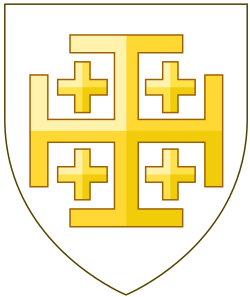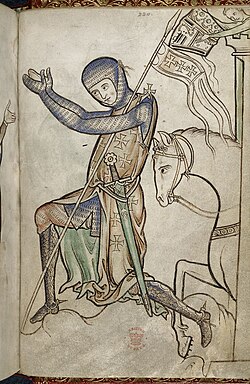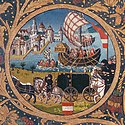Křížová výprava roku 1197
| Křížová výprava roku 1197 | |||
|---|---|---|---|
| konflikt: Křížové výpravy | |||
 Znovudobytí Bejrútu, Alexandre Hesse, 1842 | |||
| Trvání | 22. září 1197 – 1. července 1198 | ||
| Místo | Levanta | ||
| Výsledek | úspěch křižáků | ||
| Změny území | Bejrút a Sidón připojeny zpět k Jeruzalémskému království | ||
| Strany | |||
| |||
| Velitelé | |||
| |||
| Síla | |||
| |||
| Ztráty | |||
| |||
| Některá data mohou pocházet z datové položky. | |||
Křížová výprava roku 1197 byla dílčí křížovou výpravou v pořadí mezi třetí a čtvrtou. Byla iniciována římskoněmeckým králem Jindřichem VI. z dynastie Štaufů za účelem pomoci ztenčujícím se křižáckým státečkům v Levantě a její účastníci pocházeli zejména z Říše, proto bývá někdy nazývána německou křížovou výpravou (Deutscher Kreuzzug) nebo také císařskou (kvůli rozlišení od třetí zvané královské).
Samotný král Jindřich VI. se jí však nezúčastnil, neboť nečekaně zemřel krátce před svým odjezdem v Messině 28. září 1197. V Říši napjaté vztahy mezi Štaufy a Welfy zosobněné Filipem Švábským a Otou IV. Brunšvickým přerostly do otevřeného soupeření o moc. Mnozí účastníci kruciáty proto svou účast na tažení ihned přerušili a spěchali do Německa, aby ochránili své postavení a zájmy. Zbylí křižáci připluli do Svaté země a podařilo se jim dobýt pobřeží mezi Týrem a Tripolisem, které bylo nyní v muslimských rukou. Po dobytí měst Sidónu a Bejrútu byla výprava ukončena. Získaná města a území byla navrácena Jeruzalémskému království, k němuž ještě donedávna patřila, lze tedy výpravu považovat za úspěšnou.
Galerie
Jindřich VI. a papež Celestýn III., Liber ad honorem Augusti, 1196
Fridrich I. na křížové výpravě do Svaté země v rodokmenu Babenberků kolem roku 1490
Reference
V tomto článku byl použit překlad textu z článku Crusade of 1197 na anglické Wikipedii.
Externí odkazy
 Obrázky, zvuky či videa k tématu Křížová výprava roku 1197 na Wikimedia Commons
Obrázky, zvuky či videa k tématu Křížová výprava roku 1197 na Wikimedia Commons
Média použitá na této stránce
Autor: Heralder, Licence: CC BY-SA 3.0
Arms of the Archduchy of Austria
Flag of Ayyubid. The Ayyubid dynasty is often represented by the colour yellow.
"The Ayyubids and Mamluks, who succeeded the Fatimids in Egypt and Syria, retained the association of yellow with the ruler." Jane Hathaway, A Tale of Two Factions: Myth, Memory, and Identity in Ottoman Egypt and Yemen, p. 97.(c) Heralder, CC BY-SA 3.0
Arms of the Holy Roman Emperor, (Frederick I, Henry VI, and Frederick II.) Attributed with personal arms escutcheon.
Autor: Heralder
Cross by Katepanomegas, Licence: CC BY-SA 3.0
Arms of the Kingdom of Jerusalem
Red_St_George's_Cross
Used by Archbishopric-Electorate of Trier 898–1794 (Erzbistum Trier)
A kneeling knight with his horse before setting off on the crusades. His servant leaning over the turret with his masters helmet.From the Westminster Psalter, BL Royal MS 2 A xxii f. 220
Autor: thespoondragon, Di (they-them), Licence: CC0
Reconstruction of Saladin's personal standard, using a double headed eagle. The specific design of double headed eagle is taken from a coin of a later Ayyubid Sultan, Al-Adil I.
Saladin, the Sultan of Egypt, carried a yellow banner emblazoned with an eagle, possibly inherited from the Zengid dynasty.[1] The Cairo Citadel has a carving of an eagle believed to depict Saladin's emblem, which is missing its heads. According to the Ottoman researcher Evilya Çelebi, it likely originally had two heads,[2] but the carving is commonly depicted with a single head, such as by the Egyptian government on stamps, and in the Lebanese book Saladin: The Story of the Conflict Between the East and West in the 12th and 13th Centuries.
Autor: Samhanin, Licence: CC BY-SA 3.0
Coat of arms of the Duchy of Brabant. This particular COA is from the Ingeram Codex (1459).
Autor: Sir Iain, lion and crown by User:Sodacan, Licence: CC BY-SA 3.0
Arms of the Palatinate, without the Bavarian quarter.
Coat of arms of the Bishopric of Passau
Friedrich I. auf Kreuzfahrt in das Heilige Land, Babenberger Stammbaum, um 1490, Stift Klosterneuburg.
Autor: James2813, all elements drawn by Sodacan and Heralder, Licence: CC BY-SA 4.0
Coat of arms of the kingdom of Cyprus.
Coat of Arms of the (Prince-)Bishopric of Hildesheim.
Coat of Arms of the Bishopric of Halberstadt.
Autor: Vlastní dílo, Ronald Preuss (eagle), Licence: CC BY-SA 4.0
Royal banner (Königsbanner) of the German kings and emperors in the early to mid 14th century. The upright rectangular shape of the field approximates the proportions of 14th-century military banners, see e.g. File:Codex Balduini Trevirensis - Alpenüberquerung Heinrich VII.JPG






















